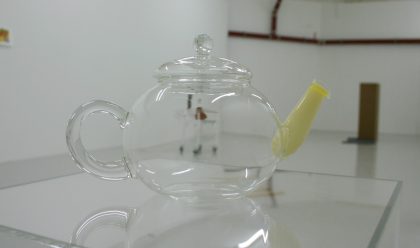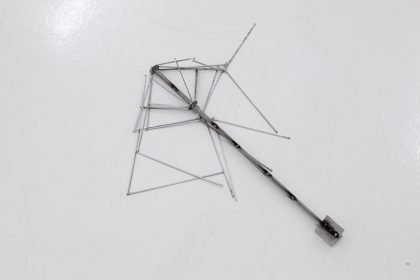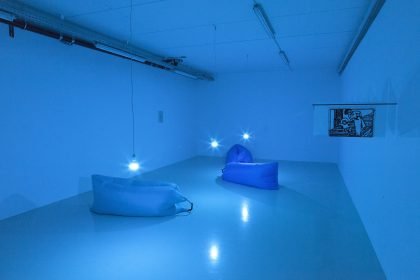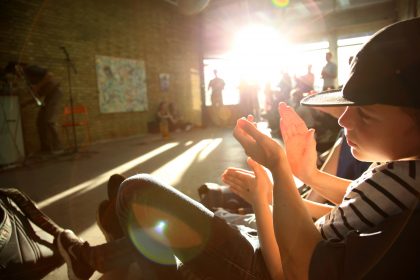
Betalt indhold
Pressemeddelelse:
Text by Anne Kølbæk Iversen:
…I tried to explore scientific discourse not from the point of view of the individuals who are speaking, nor from the point of view of the formal structures of what they are saying, but from the point of view of the rules that come into play in the very existence of such discourse (…) to give it, at the time when it was written and accepted, value and practical application as scientific discourse…
(Foucault, “Foreword,” The Order of Things, 1994 (1970), xiv).
There is an intricate connection between the geological processes of Greenland — formed over unfathomable timescales and manifested in its rock formations and occurrences of minerals — and the colonial and neo-colonial relations between Greenland and Denmark.
What connects the Disko Island off Greenland’s west coast to the photogeological laboratory at the national geological survey (GEUS) in Copenhagen is an exchange between local sites and the equipment, crew, and taxonomies used to observe, describe, and represent the data they contain. Since 1946, GEUS has produced and kept maps of Greenland, making topographical and geological maps showing the structure of the geology and mapping raw materials in the underground. Today, the extraction of data for the production of 3D photogeological maps mainly serves the purpose of mineralization.
Immaterial extraction lays the ground for material extraction.
With the exhibition (Im)material Extraction Tinne Zenner maps out this mapping of a territory through a multi-channel installation containing 16mm film loops, smart glass screens, sound showers, and a LED-subtitled narrative of three GEUS geologists explaining their mapping. The films display samples of topographic and photogeological maps of Greenland produced and archived at GEUS as they are presented by staff members of the institution. Additionally, one of the films presents an abstraction of the so-called pole lines from the photogeological maps traced onto the 16mm analogue film through laser engraving, thus transferring the cuts made into the Greenlandic landscape and culture through analysis, datafication, and mineralization onto the film strip.
The Disko Island and surrounding area has been alternately opened and closed by ventures of trade and mining through its modern history — first in the 18th century when Hans Egede opened his first trading station in Ilulissat (then Jakobshavn) and in the 20th century through the establishment and subsequent closing of the coal mine Qullissat involving the forced displacement of the city’s inhabitants. The Disko-Nuussuaq area is that, which currently holds most licenses for the extraction of minerals in the whole of Greenland. With the enactment of Self Rule in 2009, the rights to resource extraction were restored within the country leading to future self-sufficiency and further independence from the Danish State. The mapping, however, has stayed with the national Danish geological survey. As one of the researchers explain, this collaboration is negotiated every now and then.
Looking at the historical maps presented in the films discloses the stratification of not simply the landscape but of the investigations of this particular area as well, shifting between Greenlandic, Danish, and English place names (toponyms).
Photogeological mosaic. Nûgssuaq area Greenland. Prepared for Quebec Mining and Exploration Company Ltd. Scale 1: 50,000. This is a semi-controlled map-mosaic and should not be mistaken for an accurate geographic base. J.C. Sproule and associates ltd., Calgary, Alberta. August 1969.
Greenland shares with other colonized territories the experience of having an intimate language for things and surroundings overwritten by an allegedly universal language of science. This story is almost too banal to retell: how a once familiar landscape, laid out with recognizable formations of rocks and inhabited by animals that all have a designated function and relation to the cycle of life of the group, is suddenly transformed into a pool of countable, valuable entities, written into tables of stock and sales, connected to a royal economy in a country far far away, creating a rift between sites of extraction and sites of knowledge, power, and profit. It is the tale of heroic travelers and explorers exploring territories that was already inhabited and known by someone. Not peoples, just people. Foucault in The Order of Things reflects on how the loss of what is ‘common’ to place and name leads to uneasiness. “Atopia, aphasia.”
If scientific knowledge production is itself an abstraction and mediation of empirical data, a study of how this knowledge is produced, visualized, and communicated becomes a mediation on mediation.
The researchers at GEUS play a key role in the narrative of (Im)material Extraction, embodying the skills and knowledge of the institution and the state of the land. Through a transmission of their recollection of methods and results, Zenner becomes a medium for this particular discourse, emphasizing but also shifting its message through performing it.
Through the various transferences, translations, and transpositions brought forth through the works, Zenner lays bare an aesthetics of colonial and neo-colonial extraction, asking how knowledge is represented, mediated, and embodied. The smart glass screens that intermittently turn on and off come to embody the table on which things and their names are put into connection, the system within which categories and taxonomies are made visible and knowledge produced.
What landscape are we left in when the screens fade and distinctions disappear?
Dette indhold er produceret i samarbejde med et udstillingssted som en del af udstillingstedets Artguide-abonnement hos kunsten.nu.
Kunsten.nus uafhængige redaktion har intet at gøre med indholdet.






